30.09.2019
SpaceX CEO Elon Musk provides update on Starship program
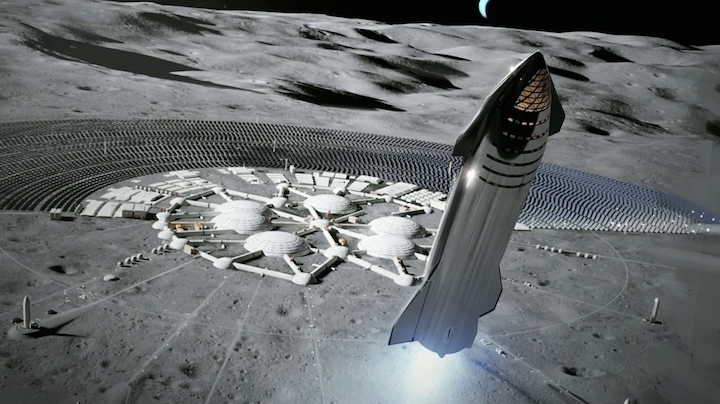
SpaceX CEO Elon Musk presented the latest update on the Starship/Super Heavy program on Saturday from the company’s facility in Boca Chica, Texas. The event was held in front of the first fully assembled Starship prototype, which will be performing its maiden test flight in the coming weeks. During the presentation, Musk provided an overview of the current design and provided a roadmap for future developments.
Saturday’s event was held on the 11-year anniversary of SpaceX’s first successful launch into orbit. That mission used a Falcon 1 vehicle which has since been retired in favor of the Falcon 9 and Falcon Heavy rockets. In total, SpaceX has successfully launched 77 additional missions since then – along with adding propulsive landing capabilities to their vehicles.
SpaceX aims to continue to build upon their rapid progress over the past decade with the Super Heavy and Starship program.
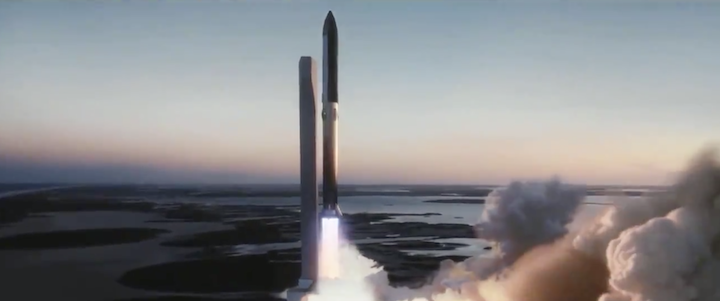
The Super Heavy and Starship vehicles are being designed to have a large enough payload capacity to be able to send crews and cargo to the surface of the Moon and Mars while still being fully reusable.
Super Heavy refers to the first stage of the launch system which helps to lift the Starship spacecraft out of Earth’s atmosphere. Then, the Super Heavy booster will propulsively land either on a landing zone near the launch site or downrange on an ocean platform.
Meanwhile, the Starship spacecraft will continue on to orbit and deliver the cargo to its destination. During some missions such as those to the surface of Mars, the vehicle may be refueled by other Starship vehicles along the way.
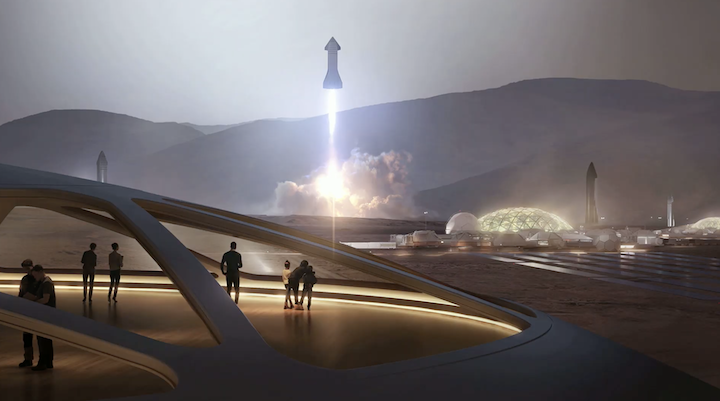
Upon arrival, the reusable spacecraft will be capable of landing propulsively on the surface of the Moon and other planets. Starship also features fins which help the vehicle navigate through the atmospheres of planets such as the Earth and Mars.
Starship’s aero surfaces have changed numerous times over the years – with last year’s design featuring a three fin configuration that also acted as the landing legs.
The engineers have since settled with a version that features two large fins on the aft of the Starship and two smaller fins on the nosecone. The four fins will need to make very fast adjustments during reentry, and thus must be capable of articulating very quickly.
Musk showed off an animation of a Starship landing at Saturday’s event.
To make that happen, SpaceX is capitalizing on technology from Musk’s electric car company, Tesla. Starship’s fins will be powered by electric motors which will utilize the carmaker’s battery packs, stated Musk in a pre-event Tweet earlier this week.
SpaceX will soon begin performing high altitude test flights of Starship to practice the reentry maneuvers. These flights will be utilizing two prototype vehicles called Mk1 and Mk2.
Mk1 is based out of SpaceX’s Boca Chica, Texas-based launch facility while Mk2 is based out of Florida and will be launching from Pad 39A at Kennedy Space Center.
Both of the launch sites have been undergoing modifications in recent weeks to prepare for the flights.
The first test flight will see the Starship Mk1 fly to 20 kilometers from Boca Chica and then land on a landing zone adjacent to the launch pad. This test flight is approximately one to two months away, said Musk at Saturday’s event.
From there, Musk stated that the next flight after that might be all the way to orbit with a Super Heavy booster. This could utilize the Mk3 vehicle, which will be built in Boca Chica and will begin construction in about a month.
“This may sound nuts, but we want to reach orbit in about six months,” Elon said.
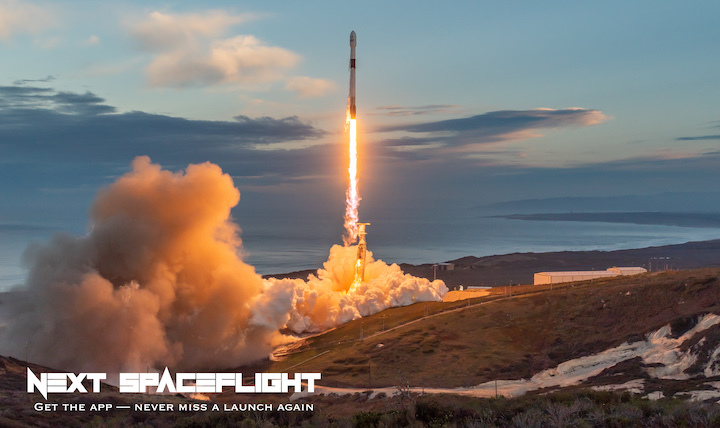
He did not elaborate on when the Mk2 vehicle could first fly.
The upcoming test flights will also be the most demanding test yet for the Raptor engines which will power both Super Heavy and Starship.
SpaceX has currently produced 12 full-scale prototypes of the methane fueled engines. Like all test campaigns, there have been setbacks along the way, but steady progress continues to be made.
SpaceX recently completed a second test bay at their test facility in McGregor, Texas. This allows for two engines to be tested in quick succession as the production rates of the engines ramp up.
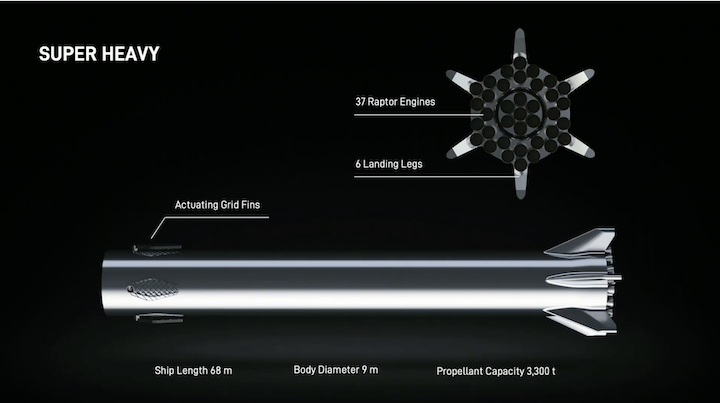
Current plans call for the Super Heavy vehicle to have 37 sea-level optimized Raptor engines – a number that has fluctuated over the years.
Of the 37 engines, only the seven center engines are capable of gimbaling.
Super Heavy’s engines will be surrounded by six landing legs. While the legs are enclosed in a fin-like structure, they do not provide control during landing. Instead, Super Heavy will navigate utilizing its grid fins, reaction control thrusters, and engines.
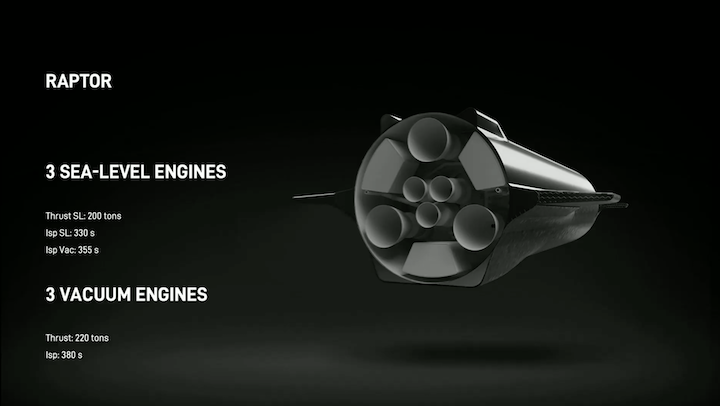
Starship will feature three sea-level engines and three vacuum optimized engines. According to Musk, the sea-level engines will feature a high range of gimbal. Meanwhile, the vacuum optimized engines will have their nozzles fixed to the base of the Starship vehicle for stability.
The vacuum Raptors will not need to gimbal, as the sea-level optimized engines can still be used in a vacuum to steer the vehicle – albeit for slightly less performance.
Three large storage containers are also found at the base of the spacecraft and fill the extra space adjacent to the vacuum optimized engines.
As far as production, Musk stated that the goal is to have two Starships constructed at each of the Florida and Texas-based facilities before working on the first Super Heavy vehicles.
Producing the Raptor engines is currently the biggest constraint for mass-producing the vehicles.
The current production rate is one every eight to ten days – with a target of getting to a rate of a Raptor a day by the first quarter of 2020.
However, the reusability of the Super Heavy and Starship vehicles will greatly help to expedite the testing program, as they will not have to build a new rocket each time, according to Musk.
Quelle: NS
+++
Elon Musk, Man of Steel, reveals his stainless Starship
"Honestly, I'm in love with steel."
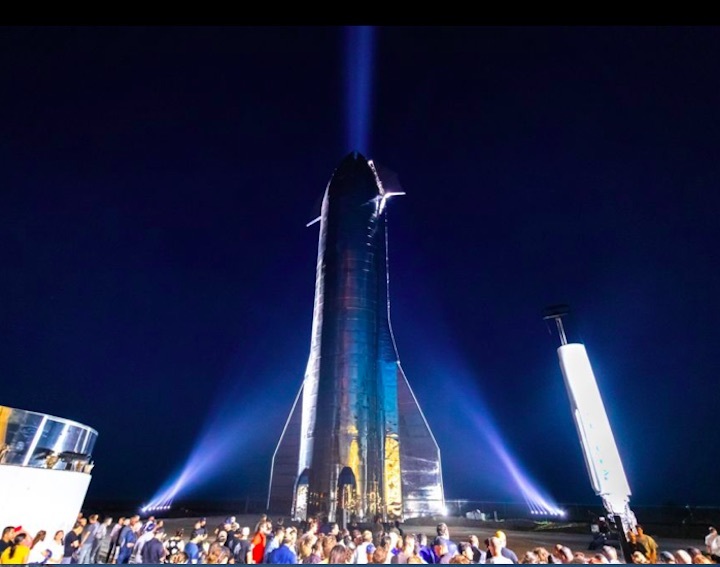
BOCA CHICA BEACH, Texas—Elon Musk spoke about his vision of a brighter future for humanity on Saturday evening in South Texas.
Musk acknowledged that there are a lot of problems here on Earth, and it is important for those to get fixed. But it is also important to give people hope for the future and a sense of optimism. He believes the exploration of space, and human expansion into the Solar System, provides this kind of a hopeful vision.
And so, beneath a big Texas sky full of stars, he offered hope in the form of a large spaceship. Mere hours after a team of SpaceX engineers, technicians, and contractors completed assembly of a prototype of the Starship vehicle, Musk revealed it to the world. He did so in an open-air shipyard by the Rio Grande River, where he intends to build dozens if not hundreds of Starship spacecraft.
The prototype loomed behind Musk as he addressed a crowd of a few hundred people, including employees, local residents from Brownsville and surrounding towns, and members of the media. Earlier, as the Sun dipped below the horizon, reddish hues glinted off the Starship's surface. As night fell and Musk climbed onto a small dais, it rose tall, dark and imposing.
"This is the most inspiring thing that I have ever seen," said Musk, dressed in a black blazer, t-shirt, and jeans, of the towering spaceship. The crowd cheered. In the moment, Mars seemed a little closer than it had before.
Progress
Three years ago, Elon Musk took the stage in Guadalajara, Mexico, to share the full scope of his Mars ambitions for the first time. He spoke of building a large, interplanetary spaceship—it was not yet named Starship— and a large rocket booster with dozens of engines that would carry 100 people to Mars at a time.
At the time, it seemed audacious, mad, and brilliant at the same time. But mostly the vision seemed like science fiction. Standing in a field in South Texas on Saturday night, it felt a little more like science, and a little less like fiction.
Three years ago, the idea of flying 37 engines on a single rocket seemed fanciful. And then, in early 2018, the company launched with Falcon Heavy with 27 engines. Three years ago, the notion of landing and re-flying a large rocket multiple times seemed distant. But now SpaceX has done this dozens of times.
But most futuristic of all seemed the notion of a 50-meter tall spaceship that could launch into space, fly on to the Moon or Mars, and return to Earth. And yet this was what Musk put on display with the Starship Mk 1 vehicle. Soon, perhaps within one or two months, it will launch to an altitude of 20km. Simultaneously, the company is building a second prototype, Mk 2, in Cocoa, Florida. It will start work on a third version in Texas later this fall, and so on.
Each design will iterate on the last. Engineers will look for ways to shave mass—the Mk 1 prototype weighs 200 tons, and SpaceX would like to eventually cut the overall mass to 110 tons to maximize Starship's lift capacity. Ultimately, a slimmed-down Starship should be able to lift 150 tons of payload into low-Earth orbit, Musk said. Its first orbital flight, launched by a big booster named Super Heavy, could come next year.
This payload capacity is more than any other launch system built before, and would be especially remarkable given that SpaceX has designed both the booster and Starship to be fully reusable. "A rapidly reusable orbital rocket is only barely possible given the physics of Earth," Musk said.
Man of steel
During the presentation, Musk offered several updates on changes to Starship's design. However he spent the most time discussing the use of stainless steel as the skin of the vehicle. "Stainless steel is by far the best design decision we have made," he said.
Yes, Musk said, steel is heavier than carbon composite or aluminum-based materials used in most spacecraft, but it has exceptional thermal properties. At extremely cold temperatures, stainless steel 301 does not turn brittle; and at the very high temperatures of atmospheric reentry, it does not melt until reaching 1500 degrees Centigrade. Starship therefore requires only a modest heat shield of glass-like thermal tiles.
Another benefit is cost, which matters to a company building Starships on its own dime, with the intent to build many of them. Carbon fiber material costs about $130,000 a ton, he said. Stainless steel sells for $2,500 a ton.
"Steel is easy to weld, and weather resistant," Musk added. "The evidence being that we welded this outdoors, without a factory. Honestly, I'm in love with steel."
Quelle: arsTechnica
+++
Tesla on Mars addressed by Elon Musk in SpaceX’s Starship Q&A session
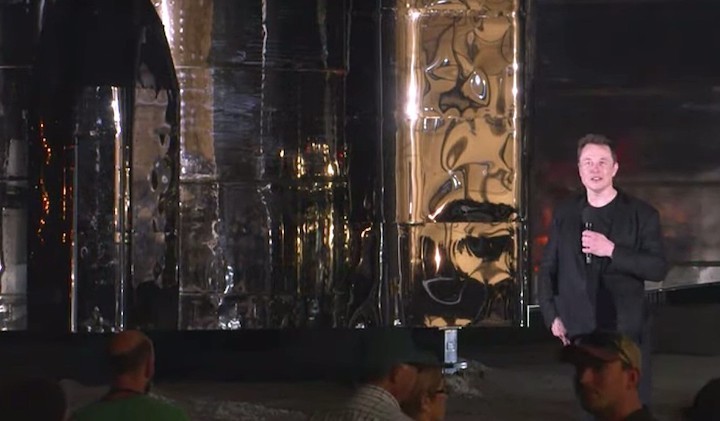
Tesla and SpaceX CEO Elon Musk spent his weekend in Boca Chica, Texas conducting a Q&A session in front of the massive Starship Mk1 Prototype.
“Starship will allow us to inhabit other worlds. To make life as we know it multiplanetary,” Musk said. He has spoken about making a transportation system that would allow for the transport of humans and resources between planets since 2016. However, his goals of making other planets inhabitable for humans has been something he has worked toward since 2001 with the Mars Oasis greenhouse project.
Amid speculation regarding the Starship and its systems, some members of the media asked Musk about the plans that Tesla has for life outside of Planet Earth.
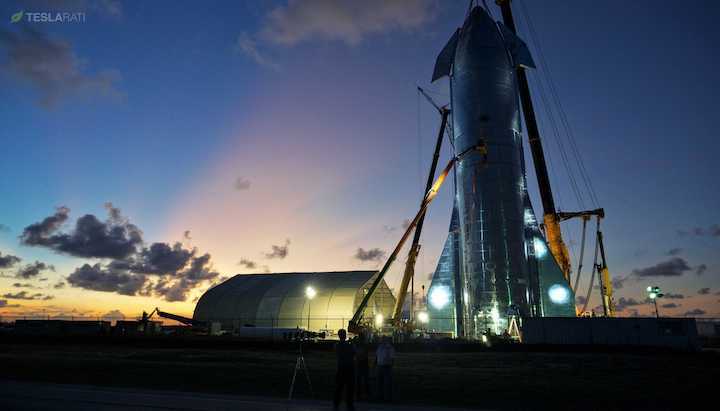
Starship Mk1 is pictured here on September 27th, less than half a day after technicians stacked the prototype’s two halves. (Teslarati – Eric Ralph)
Space Reporter Robin Seemangal asked the Tesla and SpaceX founder about whether the company will begin planning a Tesla vehicle that will operate on other planets. “Is there a concept for a Tesla Mars Rover,” asked Seemangal.
“Well, actually, Teslas will work on Mars. You can just drive them, pretty much, because electric cars don’t need oxygen, they don’t need air. So you can just drive them around, no problem,” Musk replied.
It is well known that Musk has planned to expand future human civilizations outside of the Earth. But instead of the stereotypical and “normal” rovers that are used by NASA and other space campaigns across the world, Musk envisions any of Tesla’s current models making it to intergalactic showroom floors. Perhaps one of Musk’s driving factors for creating an electric car was always the fact that battery-powered vehicles would operate in Space.
Robin then asked about the probability of a Boring Company machine to Mars or the Moon when it is inhabitable by humans.
“I think that would be a good idea. Because you could just make as much room as you want underground. And you protect it from radiation and everything and you could use the materials for building. And you’ll need to mine ice and dirt anyway, so why not,” he replied.
Robin finished up by saying “I don’t believe you about the aliens.”
Musk laughed and said “I hope I’m wrong,” while looking up at the sky. “Well, if they’re here, I hope they’re nice. They haven’t killed us yet, so they must be not that bad.”
Quelle: TESLARATI
+++
Elon Musk upbeat on Starship test flights
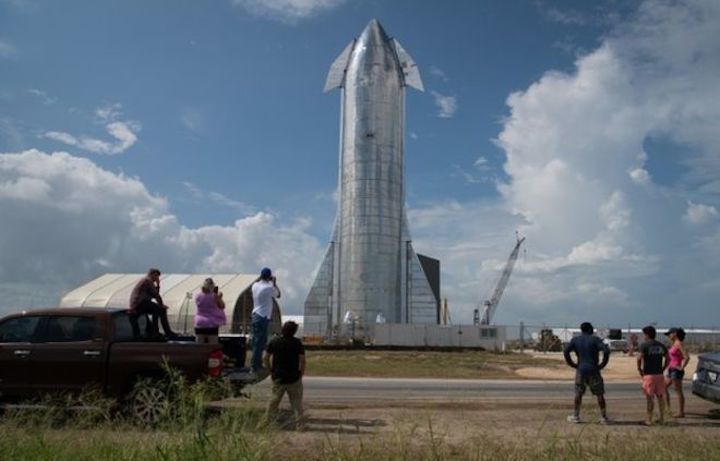
The Mk1 Starship will begin high-altitude tests in the coming weeks
The American entrepreneur Elon Musk has given a further update on his Starship and Super Heavy rocket system.
He plans to use the new vehicles to send people to the Moon and Mars, and also to move them swiftly around the Earth.
The SpaceX CEO is in the process of building prototypes and plans to start flying them in the coming months.
The Mk1 version of his Starship would begin high-altitude tests in the next one to two months, he said.
"This is the most inspiring thing I've ever seen," the entrepreneur told an audience gathered at the company's Boca Chica, Texas, facility where the prototype has been assembled.
"So this thing is going to take off, fly to 65,000ft, about 20km, and come back and land. So that giant thing, it's really going be pretty epic to see that thing take off and come back."
The 50m-tall Starship will eventually fly atop its booster, the Super Heavy.
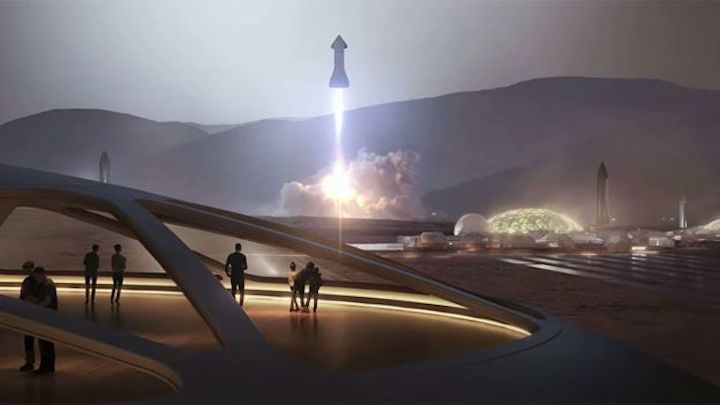
A first test flight of this booster, carrying a Mk3 Starship, could go to orbit as early as next year, Mr Musk said.
"This is going to sound totally nuts, but I think we wanna try to reach orbit in less than six months. Provided the rate of design improvement and manufacturing improvement continues to be exponential, I think that is accurate to within a few months."
Both parts of the new rocket system, which together will stand 118m tall on the launch pad, are being designed to be fully reusable, making propulsive landings at the end of their mission.
Mr Musk is well known for his aggressive scheduling, which even has a name: "Elon time".
The scheduling often slips, but eventually he does tend to deliver.
Mr Musk has given updates on the development of the new rocket system at regular intervals. He wants these future vehicles ultimately to replace his current fleet - the Falcon 9 and its bigger cousin, the Falcon Heavy.
He already has one customer on the books for a Starship flight - the Japanese Billionaire Yusaku Maezawa, who desires to go around the Moon and back with a group of artists.
Speaking at the Boca Chica event, the CEO outlined his latest thinking on the use of materials, changes in aero surfaces and the progress being made with the methane-burning Raptor engines that will power both the Starship and the Super Heavy.
The SpaceX boss explained his switch to using stainless steel over carbon fibre in building the Starship was in part down to cost. Steel is $2,500 per tonne whereas carbon fibre is $130,000 per tonne.
But he also championed the performance of steel at both low and high temperatures.
The Starship will feature heat-resistant "glass" tiles in those areas likely to experience the highest temperatures during a descent back through the atmosphere.
He also pointed to the four fins - two at the front, two at the rear - that will help control that re-entry; and to the Raptor engines. The Mk1 prototype has three, but operational versions will have six.
The Super Heavy booster, on the other hand, could have up to an extraordinary 37 Raptors all firing in unison.
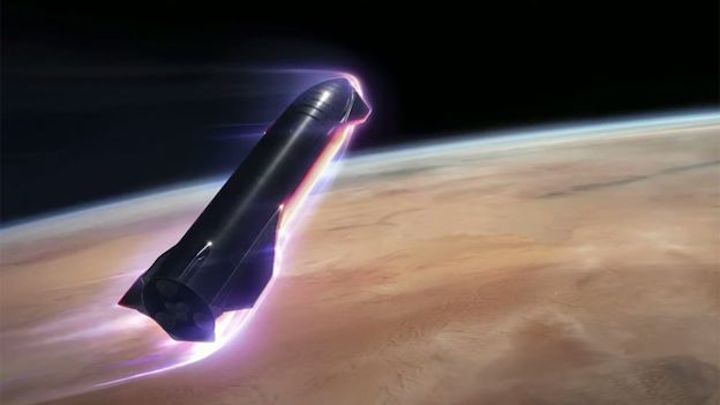
Artwork: The Starship will need heat-resistant tiles on its leading surfaces for re-entry
Mr Musk will be using Cape Canaveral in Florida for some launches, but Boca Chica also features in his flight plans.
This, he recognises, would mean considerable disruption for local residents, and the SpaceX company is therefore trying to buy them out.
"We've made an offer to that effect," he said.
Mr Musk has been criticised in the past for obsessing about going to Mars when there are many issues that need attention here on Earth.
He told his audience that the problems on our planet were not a reason to stop looking outwards.
"There are many troubles in the world, of course, and these things are important and we need to solve them. But we also need things that make us excited to be alive, that make us glad to wake up in the morning and be fired up about the future, and to think, yeah, the future is going to be great. Space exploration is one of those things."
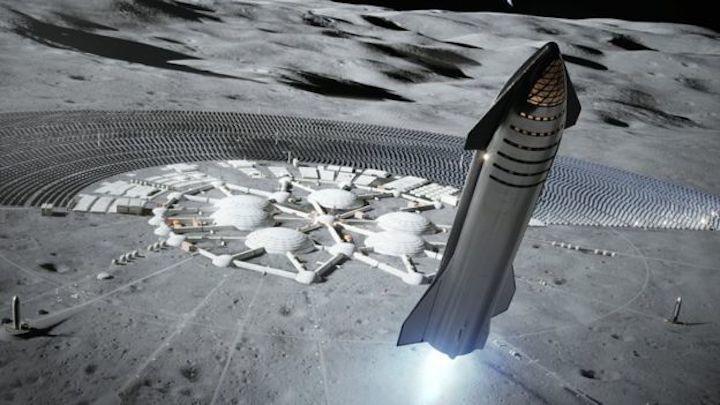
Artwork: Mr Musk says a Starship could put 100 people on the Moon
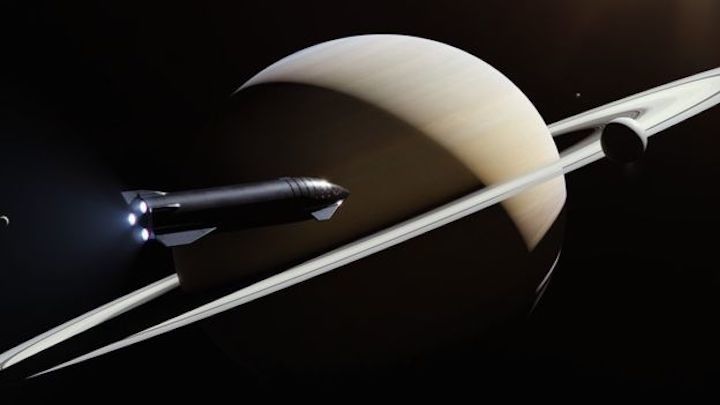
The Administrator of the US space agency, Jim Bridenstine, put out an interesting tweet on the eve of the Boca Chica event in which he said he hoped the same enthusiasm shown for the Starship would not distract SpaceX from its Nasa commitments.
The company is contracted to the agency to deliver a Falcon rocket and Dragon capsule system capable of taking astronauts to the space station. This system is several years behind schedule.
Asked to respond to the tweet, Mr Musk said the Starship and the Super Heavy booster were drawing on less than 5% of SpaceX resources.
"Our resources are overwhelmingly on Falcon and Dragon, especially crew Dragon," he emphasised.
Quelle: BBC
----
Update: 10.10.2019
.
The question in Boca Chica: Do you take Elon Musk’s money and run?
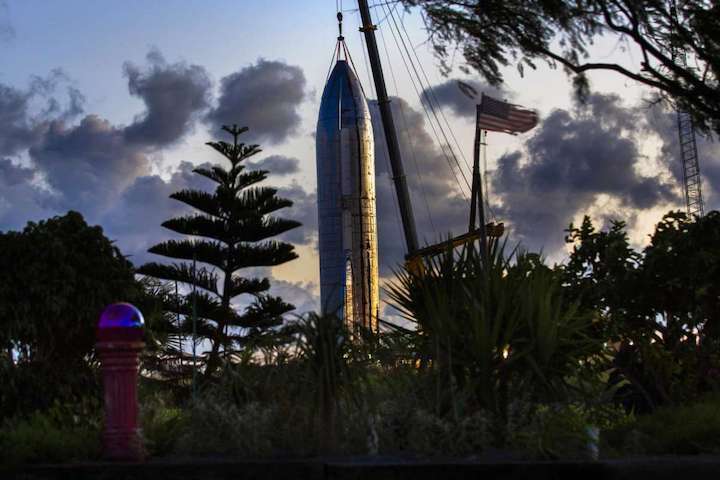
iew of SpaceX’s Starship vehicle from the front yard of Maria Pointer on Friday, Sept. 27, 2019, in Boca Chica. The SpaceX’s prototype resembling an old sci-fi movie rocket of the 50s, will be fully reusable transportation system designed to service all Earth orbit needs as well as the Moon and Mars.
BOCA CHICA — Maria and Rayford Pointer loved watching the birds. They would sit outside and marvel at the cranes, finches and spoonbills that flitted through their remote slice of South Texas.
More recently, they’ve watched the sun glint off a 165-foot-tall spaceship and listened to the cacophony of construction and traffic. Isolation, they’ve learned, is not only attractive to birds, but also commercial space companies. SpaceX, the company of billionaire entrepreneur Elon Musk, is transforming this area outside of Brownsville into a launch site for reaching the moon, Mars and beyond.
It’s a much-anticipated future for Brownsville, but one that apparently has no room for the Pointers or their neighbors in Boca Chica Village, a small community largely consisting of retirees and winter vacationers. In September, SpaceX offered to buy their homes for three times the market value, but residents say Musk and SpaceX are lowballing their offers, not only undervaluing their properties but also the lifestyles they’ve achieved here.
“At least let me have my retirement,” said Rayford Pointer. “It’s what I’ve worked for.”
